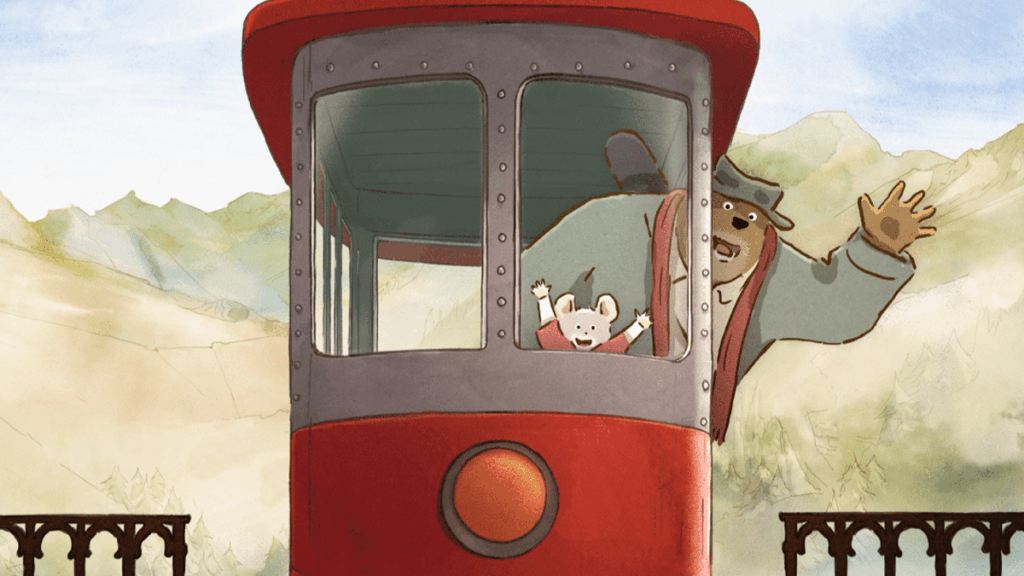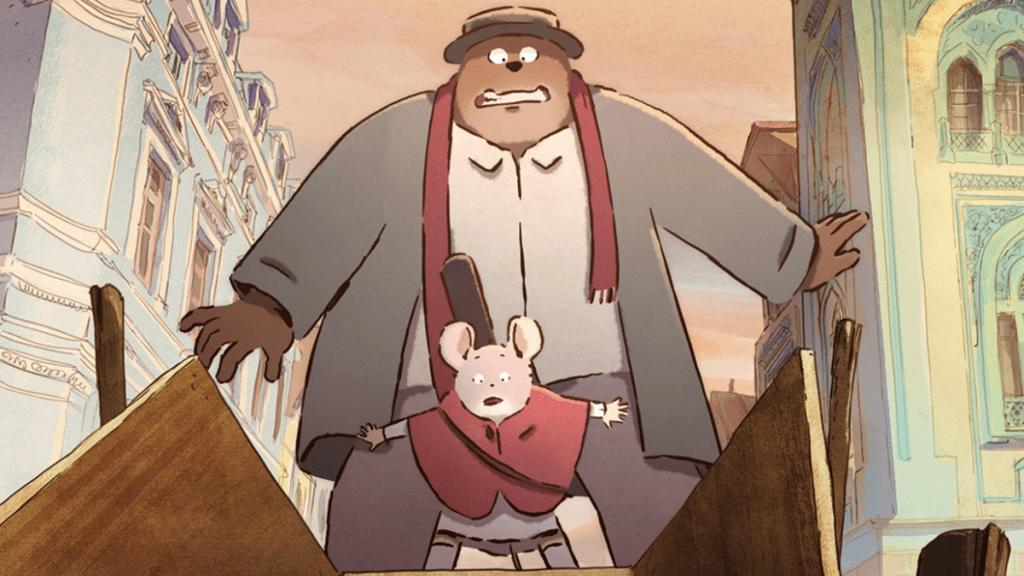ComingSoon Editor-in-Chief Tyler Treese spoke with Ernest & Celestine: A Trip to Gibberitia co-directors Julien Chheng and Jean-Christophe Roger about the animated movie. The duo discussed handing mature themes and the advantages of working together as a directing duo.
“Ernest and Celestine return to Ernest’s land, Gibberitia, to repair his precious violin,” reads the sequel‘s synopsis. “They discover that music has been banned all over the country for several years. Ernest and Celestine are joined by new friends, including a mysterious masked avenger, to try to right this injustice and bring joy back to the land of the bears.”
Tyler Treese: Can you give us your background with Ernest and Celestine?
Julien Chheng: We directed together the series Ernest and Celestine before directing the movie. I actually started my animation career on the first film as a 2D animator. So really, from the moment we met these characters, we were really in love with them. So we partnered together with Jean-Christophe into this new film with great respect for what had been done, but also with the energy to challenge the characters and the stories.
Jean-Christophe, what really helped you after working on the television series? What lessons did you learn from it that you were able to really apply to this movie to make it bigger and better?
Jean-Christophe Roger: I’ve directed several TV series and also a feature film, and it taught me about the narrative aspect — how to find a good rhythm to tell a story. Each project is different, but you learn how to express something. Sometimes through movement, sometimes without any dialogue, sometimes you use music to tell the story. Myself and Julien, we try to use all we have learned from our background to put it in the film.
Julien, what’s interesting about this movie is we get to see Earnest go back to his homeland. What did you find most intriguing about that aspect of the movie?
Julien Chheng: When Ernest meets Celestine, he is an outcast. He’s living in the streets and playing music in order to earn a living. But he’s actually not from the country. He’s an immigrant, and he comes from a remote country that we didn’t hear of. This country is Gibberitia and Celestine actually discovers that he fled this home country and she really wants to discover why he fled. That’s the starting point of the journey, really.
Jean-Christophe, we get to see that duo’s friendship really begin in the first movie. What’s different about your approach and the sequel? Viewers are already familiar with their rapport, so how does that impact the creative process?
Jean-Christophe Roger: Yeah, the first movie and also the TV series that we directed is, visually, very based on Gabrielle Vincent’s drawings,. It’s always in a small village, inspired by the countryside in France or Belgium, and suddenly we have a story that we bring our characters to a very remote and imaginary place, Gibberitia. So we had to create a world connected to Gabrielle Vincent’s art, but also where we can completely develop the story, which Ernest comes back to his own country and he has to change. He has to make his own country change. He has to resolve why he left this country. He has to resolve that issue.

Julien, when we get to his homeland, we see that music is banned except for the C note. The scene where the bird is chastised for chirping was a really nice touch. There’s a lot of cute little touches in the movie. How was it, adding those small details?
Julien Chheng: Yeah, these ideas … we love to come up with as directors. One thing is the scripts, you know? The script is detailing the action and what happens in the story. But really, the main part of our job is adding in those details that make the world lively and and really make it look like it’s real. We really enjoyed finding those small, silly ideas sometimes that, really, are not so silly, but actually mean something. This bird, who is the only character in the country who can sing all the notes, is chased out by this policeman all throughout the movie. That’s super funny because they won’t be able to take him down. He is the only free character from start to finish in this movie.
This came out last year in France. What was most fulfilling about seeing the reaction in France and seeing how fans reacted to this movie?
Jean-Christophe Roger: Well, it was fantastic to see the children dance at the end of the film and just smile and be so happy. That was amazing, to get that reward from our work. Usually you work very hard and very long doing animation, but with no opportunity to see the impact. We really went to several places in France, and we could really feel the joy of the children. They got some inspiration. Sometimes children, at the end, would just raise their hand and say, “I want to do this, and I want to do that job. I want to do this.” They feel determined they can do something with their life. It doesn’t depend on only on their parents or society. They have some determination. It was wonderful.
The original movie was so highly regarded worldwide and there’s so much excitement globally for this as well. What’s most exciting about knowing that this work is reaching a true global audience and is going to be experienced all over the globe?
Julien Chheng: It’s fantastic. It’s like the second life of the movie, and we really wanted the movie to be entertaining and appeal to a lot of audiences across the globe. Because it’s animation, it really speaks about freedom of speech and the choices that kids have in life regarding the job they want to do when they grow up. Gibberitia is actually a country where you’re not allowed to do whatever job you want to do, or you’re not allowed to play music. So it opens up two very actual questions and events that happen in the real world. That’s really great, to have children across the globe experience that.

The movie deals with a lot of themes like censorship and freedom of speech. How is working with these heavier topics while still making this appeal to children so the message sinks in and they come away thinking about what they just saw?
Jean-Christophe Roger: Gabrielle Vincent considered children to be full-fledged people, like future adults. She put all the importance in drawing books for children because she was originally a painter. So that’s the same for us. We try to find a way, because children live in the same world as grown-ups. If there is a war, if there are conflicts, they live in the same world. So we don’t want to avoid this situation. We just want to show how one person can live his life in that world. How can one person build his life? Make a dream come true? Overcome situations? It’s something that could be understandable for children. That’s what we try to do.
What’s the biggest advantage of working as a co-director of having this kind of collaborative partnership for a movie like this?
Julien Chheng: Well, itès like a duo, and it’s like our characters — they are two and they have different uh, skills and mindsets, but they always care for each other and try to find a way to reach their goal. That’s the same for us. It can be overwhelming as one person to take on a feature like this. But with Jean-Christophe, we complete each other, but it also makes us stronger for this kind of movie with so many characters and deeper meanings, different layers of entertainment, musicality, and deeper message. So yeah, it helps you focus and never lose track of the core and the heart of the film.










